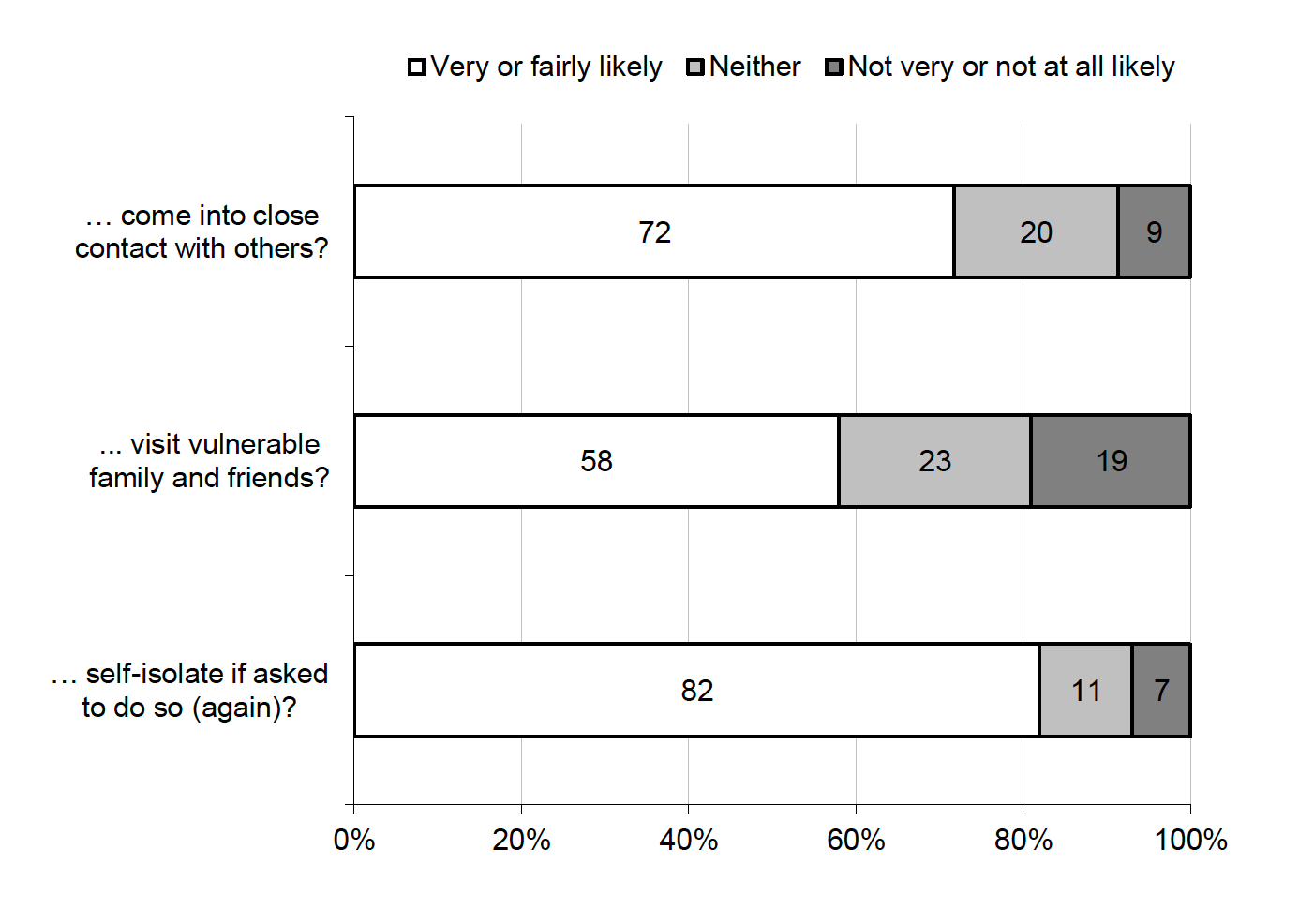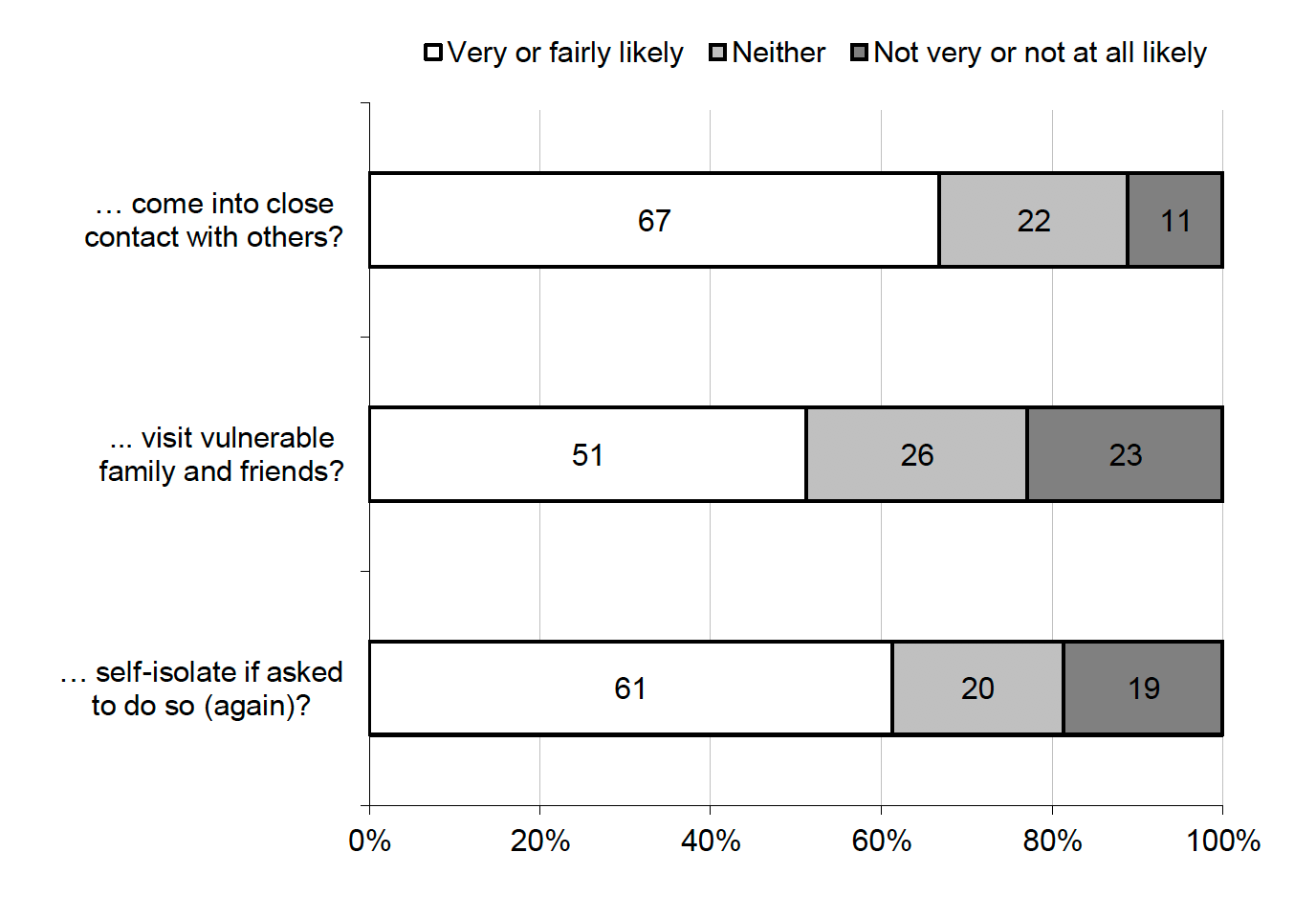Coronavirus (COVID-19) support study experiences of and compliance with self-isolation: main report
This research explores compliance with and experiences of the 10 day period of self-isolation undertaken by index cases, contact cases, and international travellers during the COVID-19 pandemic. The research took place between March and June 2021.
This document is part of a collection
7. Vaccination
7.1 Background[60]
Mass vaccinations began in Scotland in December 2020. Invitations were first issued to those within the groups identified and in the order recommended by the Joint Committee on Vaccination and Immunisation (JCVI). These determined the groups that were most vulnerable and priorities for vaccination including older age groups, the clinically extremely vulnerable, care home residents and carers, those aged 16-64 with underlying health conditions that put them at serious risk and/or who were unpaid carers. It was estimated (in March 2021), that doing so would target the vast majority (approximately 99%) of preventable mortality from COVID-19. By the end of the first wave of this study, 56% of those aged 18 and over in Scotland had received their first vaccination, while 9% had received both doses. These figures had risen to 64% and 32% respectively by the end of wave two and to 74% and 48% respectively by the end of wave 3[61].
This study aimed to learn more about the vaccination status of those asked to self-isolate, as well as the impact this may or may not have on planned future behaviour among those who had received both, one or no doses at the time of fieldwork, including whether this may differ by the reason for their self-isolation.
7.2 Vaccination status among Index and Contact Cases
7.2.1 Vaccination levels among self-isolating Index and Contact Case participants
Across the three waves of the study, half of the Index and Contact Case participants (51%) had received at least one dose of vaccine, with 15% having received both doses at the time of completing the survey. Contact Case participants were more likely than Index Cases to have been vaccinated, with three-in-five (60%) having received at least one dose and 21% having received both. Two-in-five (39%) Index Cases had also received at least one dose, with 8% having received both. [Table 7.1]
As may be expected, variations in vaccination status among Index and Contact Case participants were recorded by age. At the time of interview, eight in ten 16-24 year olds reported not having been vaccinated at all, a proportion that decreased with age to 1% among those aged 65 and over. The proportion receiving both doses, rose from 16% of 16-24 year olds to 62% of those aged 65 and over. [Table 7.1]
7.2.2 Vaccination status and overall compliance among Index and Contact Case participants
No significant association between compliance with the self-isolation regulations and vaccination status were observed. Three-quarters of all Index and Contact Case participants were fully compliant with the regulations: 76% of those who had not been vaccinated, 75% of those who had received one dose, and 73% of those who had received both doses. [Figure 7.1, Table 7.2]
| Compliance | Received both doses | Received one dose | Not vaccinated |
|---|---|---|---|
| Fully compliant | 73% | 75% | 76% |
| Partially complaint | 27% | 25% | 23% |
| Not compliant | <0.5% | 1% | 1% |
| Base | 304 | 741 | 1,007 |
7.2.3 Vaccination status and likely future behaviour among Index and Contact Case participants
The majority of Index and Contact Case participants (72%) responded that they were likely (very likely and fairly combined) to come into close contact with others once they were fully vaccinated against COVID-19. Only 9% said this was not likely. [Table 7.3]
The majority, albeit a smaller one (58%) reported they were likely to visit vulnerable family and friends once they were fully vaccinated, with one-in-five (19%) saying this was not likely. [Table 7.4]
A high level of intended future compliance with self-isolation regulations, even once vaccinations had been given, was reported. Four-in-five Index and Contact Case participants (82%) reported that they would be likely to self-isolate again if they were asked to do so once they were fully vaccinated, while only 7% said they would not. [Figure 7.2, Table 7.5]

Likely future behaviour varied by age with those under 65 more likely than those aged 65 and over to report being likely to come into close contact with others once vaccinated (72-73% compared with 62% of those aged 65 and over). Younger participants were also more likely to respond that they would visit vulnerable family once fully vaccinated (62% among 16-44 year olds and 56% among 45-64 year olds compared with 41% of those aged 65 and over). [Tables 7.3-7.5]
However, there was less of a willingness expressed by younger Index and Contact Case participants with regards to self-isolating again if asked once fully vaccinated (77% among those aged 16-24, 88% among those aged 45-64 and 93% of those aged 65 and over). [Tables 7.3-7.5]
7.3 Vaccination status among International Travellers
7.3.1 Vaccination status of International Traveller participants
International Travellers were less likely than Index and Contact Case participants to have received their first dose of vaccine. Just over a third of International Travellers (36%) had received at least one dose, with 19% having received both. [Table 7.6]
7.3.2 Vaccination status and overall compliance among International Travellers
As was recorded for Index and Contact Case participants, behavioural compliance did not differ significantly according to vaccination status among International Travellers: 72% of those who had received both doses of vaccine, 68% of those who had received one and 73% of those who were not vaccinated at all complied fully with the self-isolation regulations, with very few in any of the groups not complying at all. [Figure 7.3, Table 7.7]
| Compliance | Received both doses | Received one dose | Not vaccinated |
|---|---|---|---|
| Fully compliant | 72% | 68% | 73% |
| Partially complaint | 28% | 31% | 26% |
| Not compliant | <0.5% | <0.5% | <0.5% |
| Base | 374 | 410 | 1,399 |
7.3.3 Vaccination status and likely future behaviour among International Travellers
While the majority of International Travellers reported they would be likely to meet people once they were fully vaccinated, the proportions were smaller than for Index and Contact Cases. Two-thirds (67%) of International Travellers said they would be likely to come into contact with others (compared with 72% of Index and Contact Case participants), while 11% said this was not likely. [Table 7.8] Half of International Travellers (51%) said they would be likely to visit vulnerable friends and family, with 23% saying this was unlikely. [Table 7.9]
Three-in-five (61%) International Travellers reported that they would be likely to self-isolate again if asked to do so once they were fully vaccinated. This is significantly lower than the 82% of Index and Contact Case participants reported above. One-in-five (19%) reported it was unlikely they would do this once fully vaccinated. [Figure 7.4, Table 7.10]

Variations in likely behaviours were evident by age with International Traveller participants in the 16-24 age group more likely to come into close contact with others (70%) and/or visit vulnerable family (53%) once fully vaccinated compared with those aged 65 and over (60% and 37% respectively). However, there was less of a willingness expressed by younger International Travellers (aged 16-24) with regards to self-isolating again if asked once fully vaccinated (57% compared with 66% of those aged 45 and over). [Tables 7.8-7.10]
7.4 Opinions on vaccinations (qualitative interviewees)
Due to age profile, over half of qualitative interview participants, of all case types, had been offered the vaccine at the time of interview, most of whom had received at least one dose of the vaccine. There were participants who were waiting for new vaccine appointments after having to postpone because they were self-isolating. The remaining interview participants had not received their vaccination invitation yet but almost all intended to accept the vaccine when offered. One participant was still uncertain whether they would accept the vaccine because they were concerned about the safety of the vaccines available.
There were a number of reasons interview participants had accepted or intended to accept a COVID-19 vaccine. A motivating factor for accepting a vaccine was to protect themselves and others, believing that the vaccines were effective in reducing the risk of catching and transmitting COVID. Getting vaccinated was also perceived to be the best way to control COVID-19, get through the pandemic and ease COVID restrictions. Participants also said getting vaccinated was a way to ease pressure on the NHS. There were participants who had some concerns about getting the vaccine (a fear of needles, concerns about side effects) but on balance felt it was better to be vaccinated.
"Yes, I'll be taking the vaccine, absolutely...I just feel like it's better to protect myself and better to protect people around me I suppose. Vaccines have helped in the past with pandemics and stuff and I don't see this one being any different if I'm honest." (Index Case)
"I just feel it's the way forward. It's the only way we're ever going to get out of – not completely - but back to any kind of form of normality." (Household Contact Case)
Overall, interview participants intended to get the second dose of the vaccine when offered because it would give greater protection against COVID-19. Only one interview participant was unsure whether they would accept the second dose of the vaccine because they had an adverse reaction to the first dose.
"I think it gives an extra protection and peace of mind. Even though I had COVID, it's an extra protection." (Index Case)
"What I want to do is to make sure that I have a full, or as best a level of immunity as I can and it would only be by taking the second dose of the vaccine that that would provide me with that." (Household Contact Case)
When asked about their behaviour or intended behaviour after being vaccinated participants still perceived that it was important to follow the guidelines.
"Yes, it's hard. My heart is hurting, but if this is all we're being asked to do then I'm sorry I don't think it's been that big a hardship if it means we can get out of this lockdown and get back to some kind of normality and allow the science to play its part and for the vaccines to roll on and get everybody vaccinated. I don't see any issue with it. I'm fine with following the restrictions." (Contact Case)
Contact
Email: socialresearch@gov.scot
There is a problem
Thanks for your feedback